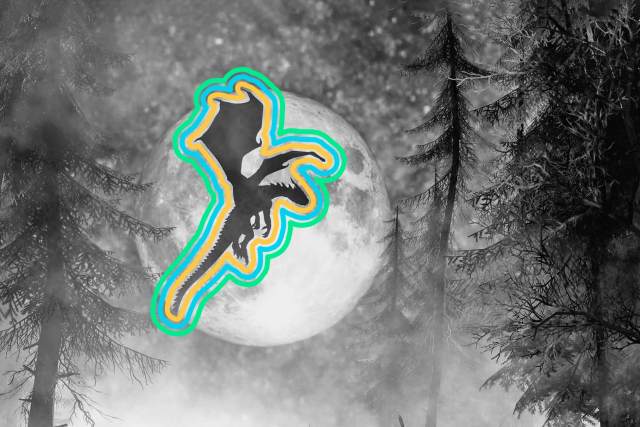
Dragon Mythology Has Existed Around the World Since Ancient Times
Nearly every region of the world has its own dragon myths, from the benevolent Chinese long to the medieval villains in Europe. Even the Western Hemisphere has ancient dragon myths.
The Rigveda, an Indian text that originated sometime around 1500 BCE, features a snake-like dragon in a creation story. In ancient Babylon, the Mushussu, a vast, cosmic dragon — mostly snake, but part eagle and lion — guarded the gates of Ishtar. The Greek drakon appears throughout ancient mythology. The Olmec people, an early civilization in the Americas dating back to at least 1200 BCE, have what archaeologists refer to as the “Olmec dragon,” a powerful god that’s part reptile, part jaguar, and part bird. The Rainbow Serpent deity of Indigenous Australians goes back at least 6,000 years.

Nobody Knows How Dragon Myths Started, But Scholars Have Some Ideas
Although dragon myths are incredibly widespread, those who study ancient folklore can only theorize about how the idea of the dragon started. Most scholars say that these stories developed independently in different parts of the world, but there are a few things that could have caused big snakes — the root of most, if not all, dragon myths — to evolve into something more legendary.
Dinosaur fossils and whale bones may have played a role in imagining these giant creatures, since most of our ancestors would have had little idea what these objects really were. One anthropologist theorizes that the idea of the dragon evolved in human minds as an amalgamation of predators like elephants, pythons, and birds of prey, which humans became hard-wired to fear. Because so many early dragon myths concern water — most regions of the world have a story of a dragon that either controls the rain or guards a body of water — one linguist theorized that rainbows are the common origin. In many early cultures, rainbows are associated with supernatural serpents who guard stores of fresh water and cause the rain to cease by drinking it.

The Medieval Western Dragon Came Along Relatively Late
For centuries, the dragon was thought of as a form of snake in Europe. But over time, the European medieval dragon — the model we typically now see in Western media like Game of Thrones and the Lord of the Rings series — evolved, especially as Christianity started spreading northward and mingling with Celtic and Germanic cultures. (Under the Christian influence, dragons often became associated with sin and Satan.)
One milestone was the epic Anglo-Saxon poem “Beowulf,” which was written between the eighth and 11th centuries (the date of its creation is unclear). In the tale’s final battle, the hero Beowulf faces a treasure-guarding, fire-breathing dragon that can fly, although the creature is still more snake than lizard. By the 13th century, winged, bipedal dragons had appeared in at least one bestiary.
This type of dragon is common in folklore throughout the European Middle Ages, but interest waned for a couple hundred years after that. The legends came back to life in the 19th and 20th centuries, thanks at least partially to the Grimm Brothers and, later, J.R.R. Tolkien, who modeled Smaug from “The Hobbit” on a few European dragons, including the Beowulf foe and the Norse dragon Fafnir.
More Interesting Reads

The Phrase “Here Be Dragons” Is (Mostly) Apocryphal
“Here Be Dragons” is a phrase that supposedly has its roots in old mapmaking, particularly before 1600 or so, as a way to indicate danger or the unknown. It’s true that cartographers often used majestic, monstrous beasts as ornaments and markers, but only one or two known early globes reference dragons specifically. No known old paper maps write out a specific dragon warning (although a couple of them do have dragons among their adornments). Fantastical drawings — of dragons, sea monsters, and more — were, in part, added to sell more maps, which were then more of a luxury item than an everyday tool.

“Puff the Magic Dragon” Was Inspired by a 1930s Children’s Poem
“Puff the Magic Dragon,” the now-classic 1963 song by Peter, Paul, and Mary, has an interesting backstory, and no, it’s not about drugs. A few years before the song was recorded, a 19-year-old college student at Cornell named Lenny Lipton had just arrived at a friend’s house for dinner. Before he left, he was reading the 1936 children’s poem “The Tale of Custard the Dragon” by Ogden Nash, a relatively lighthearted tale of a scared little pet dragon that musters up the courage to kill and devour a pirate when his friends are in danger. Feeling inspired, Lipton sat down at a typewriter at his friend’s house and wrote what would eventually become “Puff the Magic Dragon,” a tale about growing out of childhood things like imaginary dragon friends.
“Pirates and dragons, back then, were common interests in stories for boys,” he later told LA Weekly. “The Puff story is really just a lot like Peter Pan.”
At the time, Lipton didn’t put a lot of thought into it, and left his poem behind in the typewriter. It turns out his friend’s roommate was Peter Yarrow — as in Peter, Paul, and Mary — who found it and adapted it into the popular song.

A “Dragon” Skull Stood for 200 Years in an Austrian Town
The Lindwurm is a creature in Germanic folklore that’s on the snakey side of dragon: a winged serpent with brilliant green scales. It’s a troublesome beast, known for destruction and general carnage, and legend told of one that lived in the dense woods just outside Klagenfurt, Austria. So when some Klagenfurt residents found a “lindwurm” skull in a quarry in 1335, it was put on display in the town hall. An artist borrowed the skull to make a full statue of the dragon in 1582, which is still on display today in the town’s central square, along with a fountain and a statue of Hercules. It’s considered one of the first efforts to reconstruct the appearance of an animal from a fossil — even though the skull was not from a dragon, but from an Ice Age woolly rhinoceros. The skull itself is still on display in a local museum.

Komodo Dragons Love To Play
Unlike the other creatures on this list, Komodo dragons are real. Sure, they’re a little terrifying — they may drool deadly venom, are able to swallow a goat whole, and sometimes surprise people in the bathroom — but have you ever seen one playing with a bucket?
Play behavior is relatively rare in reptiles, but the world’s largest lizard is exceptional. Researchers have observed play in captive Komodo dragons that includes tug-of-war and putting bags and buckets on their heads. Other captive Komodos can tolerate leashes, enjoy massages, and even come when they’re called, proving that they’re far more complex creatures than the killing machines they sometimes appear to be.












